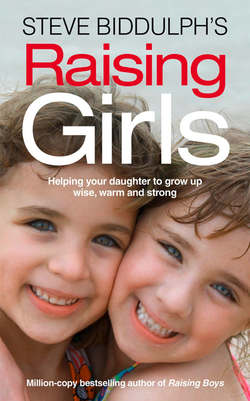Читать книгу Steve Biddulph’s Raising Girls - Steve Biddulph, Steve Biddulph - Страница 30
Learning to Connect
ОглавлениеAs her mum goes about her activities around the house, or at her computer, if Lucy gets lonely she will make sounds to attract her mum’s attention. And her mum will answer her. While Lucy will not have words for a year or so, she and her mother know exactly what the other is communicating. Roughly translated, the conversation goes like this …
Baby: ‘Are you there, beloved one?’
Mum: ‘Yes, I am!’
Baby: ‘Am I still the most important thing in your life?’
Mum: ‘Yes, you are.’
Baby: ‘Just checking!’
Mum: ‘That’s fine.’
Researchers have filmed these mother-baby exchanges using special high-speed cameras, and have given them a scientific name3: ‘Joint attention sequences’ are the little rituals when mother and baby check in with each other, and they happen dozens of times a day. These mini ‘conversations’ help make this child not just secure in her mother’s love but, as she gets older, better able to relate empathically and sensitively to other people. The timing is incredibly sensitive, they seem to sway and move in total harmony. Researchers found that if the mum is on a video screen, it still works, but if they introduce a mere one-second delay, the baby completely panics. The rhythm of this baby and this mother are totally attuned. The delicate dance of interaction, with sounds and nods, smiles and bits of sing-song, shape this little girl’s abilities to relate well for life.
Often Lucy’s cries will be more intense, if something has scared her or she has a moment of painful hunger, or because something is not to her liking. Her mother will match this startle response with, ‘Oooh, what’s wrong?’ or, ‘Oh dear, what’s the matter?’ using the higher-pitched voice that adults tend to adopt around babies. This voice is more audible to a baby’s ears. (Though nobody knew that until recently audiologists learned how to measure it.) The mother will then shift her pitch and tone to a more soothing level. She will probably pick Lucy up and rock her gently to restore some rhythmic peace. From thousands of such soothings Lucy’s brain will learn the pathway from stress to relaxation, a pathway she can use for all her life to come.
Lucy and her parents’ time together will have a quality that is called ‘responsiveness’. Put simply, they will be tuned in to her and will get to know her ways. They will read her signals and respond, not in a panicky way, but smoothly and contentedly. Partly this is simply how love (and the hormone of love, known as oxytocin) works, but partly it’s because they have made it a priority to be not too busy or rushed in these early months. (They didn’t decide to renovate the bathroom or take a big promotion right now, knowing that babyhood was a pretty demanding event on its own.) Unless Lucy’s mum is numbed out by drug addiction, or is suffering from depression, she will most likely find Lucy delightful to be around, though certainly demanding. Parenthood may not come naturally, but it will grow and settle into a new and satisfying rhythm, if she gives it time and if she has support from those around her.
Support from grandmas, friends, aunties is very important. New mums or dads can’t easily do this stage on their own, they need a bit of mothering too. Love is like a river and it has to flow in and out of us. Being close to family and friends really helps when you have a little baby.
